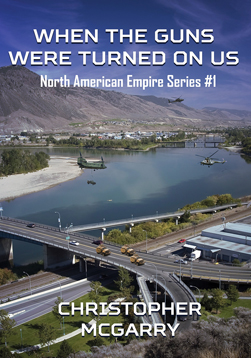Novel too ambitious for its own good
 CREDIT: SHELYSE RICHARD
CREDIT: SHELYSE RICHARDWhen the Guns Were Turned on Us had the potential to be an interesting read if there was more focus put on developing the main characters rather than all of the minor ones.
KAMLOOPS (CUP) – The first sentence in When the Guns Were Turned on Us by Christopher Mc- Garry explains exactly what this book is: the realization of right wing conspiracy theorists’ extreme predictions.
The almighty American dollar has fallen and the United States, NATO and Israel are at war with the combined forces of pretty much every country east of the Ukraine, plus Brazil for some reason.
The fall of the dollar has plunged North America into chaos, with food riots and Central Americans running amuck through the border.
North America, Central America and Caribbean nations form a political union under one currency, the Amero, with martial law, human rights statutes void and extreme right wing leadership.
Protagonist 40-year-old Jake Scribner has lived in Kamloops’ Batchelor Heights for a year. Jake’s personality consists mostly of his heroic mission to rescue his love and her child and his “borderline- ripped” bod. He’s ex-U.S. Air Force. His girlfriend Nicole is a researcher for a chemical company and runs a popular opinionated blog.
After spending considerable time establishing backstories and political intricacies, the story is kick-started when Nicole and her seven-year-old daughter, Arielle, are inevitably abducted and taken to a “re-education centre” (a prison).
Jake shoots two troopers, runs off into the wilderness and immediately encounters a grizzly bear. He gets the bear to eat his phone and a box of crackers, distracting it enough to let him get away, and misleading his pursuers into tracking the bear. The novel is full of events like this that seem both cliché and bizarre.
The third character we meet, and one of many antagonists is Frank Carragher, a man so damaged by being bullied for being overweight as a child, he now has an insatiable thirst for power. He sets his eyes on controlling the Thompson-Nicola Regional District after being relocated there by the big bad president Asher.
Carragher seems to speak mostly in awkward exposition. One of his best-forced lines is “Anyway, we should start discussing how we’re going to govern the district,” as though the reason for the meeting had eluded his colleague. In fact, most of the characters’ dialogue feels inorganic.
There are four groups to keep track of throughout the book. Jake gathers a group of dissenters, Nicole and Arielle are kept in two separate sections of the re-education centre where they meet several others, and then there is Carragher and the bevy of military men. With even minor characters given backstories, it’s a lot to keep track of.
If the effort to explain every minor character’s childhood had been put towards developing the main characters, When the Guns Were Turned on Us would be a much more interesting read. It would also make it a lot easier to root for the people the author wants us to root for.
The best example of wasted words is when Carragher’s assistant is described as “somewhat naïve”. This characterization doesn’t matter one bit because after she is introduced she is neither seen nor heard from again.
This book is full of army terminology, to the point where it could be considered military porn with a story in between.
The bare bones of When the Guns Were Turned on Us aren’t bad, but the only reason to read it is if you are really into military novels, or you’re just curious to read something set in Kamloops. Either way, it doesn’t necessarily make for an exciting first instalment of a potential series.














